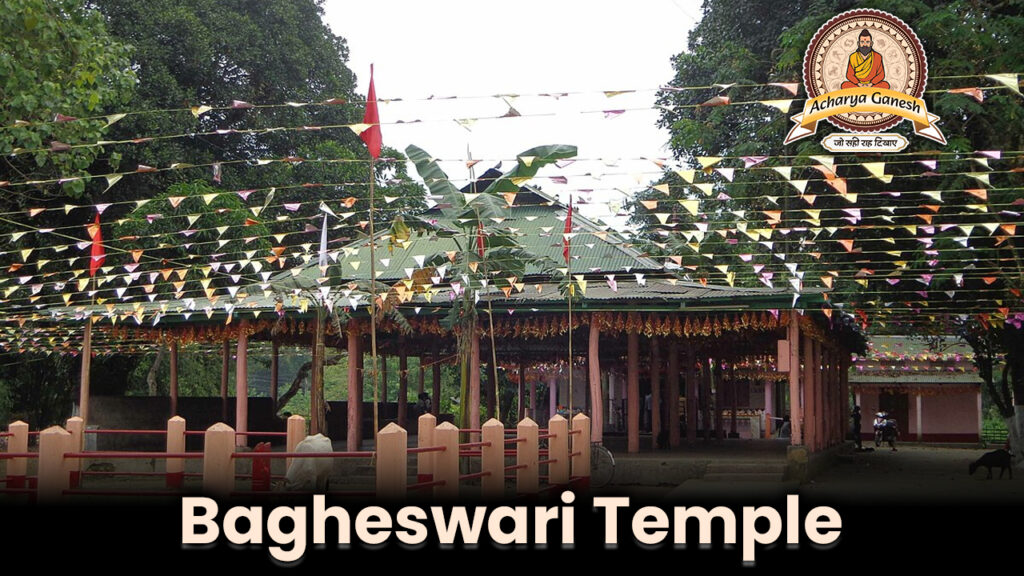Introduction to Bageshwari Temple
Nestled in the heart of Bongaigaon, Assam, the Bageshwari Temple stands as a testament to the rich cultural and spiritual heritage of Northeast India. This ancient temple, dedicated to Goddess Bageshwari, draws devotees and tourists alike with its unique charm and religious significance. As you plan your visit, understanding the best timing to visit and the temple’s opening and closing times will ensure a memorable experience.

History and Significance
The Bageshwari Temple boasts a history that spans centuries, with its origins shrouded in local legends and myths. According to folklore, the temple was established by King Naranarayan of the Koch dynasty in the 16th century. The name “Bagheswari” is derived from “Baghe,” meaning tiger, and “Ishwari,” meaning goddess, reflecting the fierce and protective nature of the deity.
The temple holds immense significance for the local population and is considered one of the most important Shakti Peethas in Assam. It is believed that the left thigh of Sati fell at this spot, making it a revered pilgrimage site for devotees of Goddess Durga.
Architecture and Design
The Bageshwari Temple showcases a blend of traditional Assamese and Koch architectural styles. The main structure features a dome-shaped roof, typical of Assamese temple architecture, adorned with intricate carvings and sculptures. The temple complex includes:
The main sanctum housing the deity
A spacious prayer hall
Several smaller shrines dedicated to other Hindu gods
A sacred pond believed to have healing properties
The walls of the temple are adorned with colorful frescoes depicting scenes from Hindu mythology, adding to its visual appeal and cultural significance.
Best Time to Visit
While the Bageshwari Temple welcomes visitors throughout the year, certain seasons offer a more pleasant experience:
- October to March: This period, encompassing autumn and winter, is considered the best time to visit. The weather is cool and comfortable, making it ideal for exploring the temple and its surroundings.
- Durga Puja: If you’re looking to experience the temple at its most vibrant, plan your visit during the Durga Puja festival (usually in September or October). The temple comes alive with elaborate decorations, rituals, and cultural performances.
- Early Mornings: Regardless of the season, early mornings offer a serene atmosphere for worship and meditation.
Temple Timings and Aarti Schedule
Understanding the temple opening time and closing timing is crucial for planning your visit:
Opening Time: 5:00 AM
Closing Time: 9:00 PM
The temple remains open throughout the day, allowing devotees ample time for darshan and prayers. However, it’s advisable to check for any changes in timings during special occasions or festivals.
Aarti Timings
The Bageshwari Temple follows a regular schedule for aartis (ritual of worship):
Morning Aarti: 6:00 AM
Afternoon Aarti: 12:00 PM
Evening Aarti: 7:00 PM
Participating in the aarti is a spiritually enriching experience, offering a glimpse into the devotional practices of the region.
Specialties of Bageshwari Temple
The Bageshwari Temple stands out for several unique features:
- Shakti Peetha Status: As one of the revered Shakti Peethas, it holds a special place in Hindu mythology and attracts pilgrims from across the country.
- Ancient Rituals: The temple preserves age-old rituals and practices, offering visitors a glimpse into traditional Assamese religious customs.
- Sacred Pond: The temple complex includes a sacred pond believed to have healing properties. Many devotees take a dip in its waters as part of their pilgrimage.
- Cultural Hub: The temple serves as a center for cultural activities, hosting various festivals and events throughout the year.
- Unique Idol: The main deity, Goddess Bagheswari, is represented in a distinctive form, different from typical representations of Durga in other parts of India.
Nearby Attractions
While visiting the Bageshwari Temple, consider exploring these nearby attractions:
- Eco Park: A beautiful park offering boating facilities and a serene environment, perfect for relaxation after temple visits.
- North Salmara: A historical site known for its archaeological remains and ancient temples.
- Manas National Park: A UNESCO World Heritage site, famous for its rich biodiversity and wildlife.
- Kakoijana Reserve Forest: Home to the golden langur, this forest reserve offers nature trails and bird watching opportunities.
How to Reach
Reaching the Bageshwari Temple is relatively easy:
By Air: The nearest airport is Lokpriya Gopinath Bordoloi International Airport in Guwahati, about 180 km away.
By Rail: Bongaigaon Railway Station is well-connected to major cities in Assam and neighboring states.
By Road: Regular bus services and taxis are available from Guwahati and other nearby towns to Bongaigaon.
Tips for Visitors
- Dress modestly, covering shoulders and knees, as a sign of respect.
- Remove shoes before entering the temple premises.
- Avoid taking photographs inside the main sanctum.
- Carry water and light snacks, especially during summer months.
- Consider hiring a local guide to learn more about the temple’s history and significance.
Conclusion of Bageshwari Temple
The Bageshwari Temple offers a unique blend of spiritual solace and cultural richness. Whether you’re a devout pilgrim or a curious traveler, this ancient shrine promises a memorable experience. By planning your visit around the best timing and being mindful of the temple’s opening and closing times, you can fully immerse yourself in the divine aura of this sacred place. As you leave, carry with you not just memories, but also the blessings of Goddess Bagheswari, whose presence continues to inspire and protect devotees through the ages.











